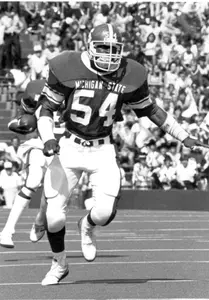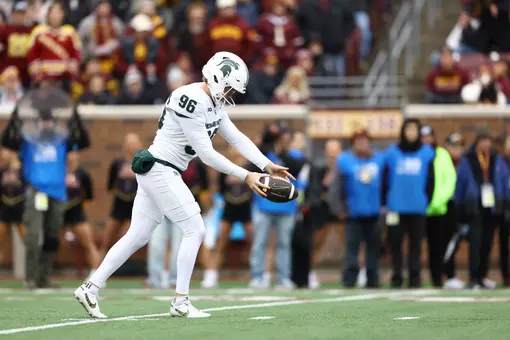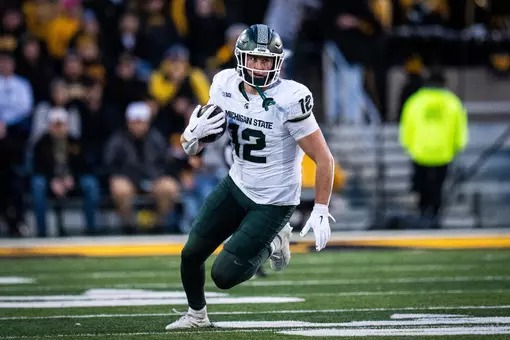
Carl Banks: Football Star & Businessman
2/28/2007 12:00:00 AM | Football
Feb. 28, 2007
February is Black History Month, and nowhere in major-college athletics is that history richer than at Michigan State University. From Gideon Smith, the first African-American football player at Michigan Agricultural College in 1913, to Steve Smith, an All-American basketball player whose contributions have a major impact today, it would take many months to tell the full story. In a series of profiles, longtime Michigan State beat writer and columnist Jack Ebling will highlight some of the greatest of the great. The eighth of those stories is football star and businessman Carl Banks.
CARL BANKS
He was never the biggest or strongest player on his team, as tough as that may be to believe. But for big contributions and strength of character, Carl Banks was tough to beat.
Though Michigan State lost twice as much as it won from 1980-83, Banks was the Spartans' first non-punter to be named first-team All-Big Ten three times. An All-America outside linebacker as a senior, Banks became the third selection in the 1984 NFL Draft, made the 1980s All-Decade Team and earned two Super Bowl rings with the New York Giants.
When the cheering stopped in 1985, he attacked business the same way he did ball carriers and built G-III by Carl Banks into a major athletic apparel company. An analyst on Giants broadcasts, he is also an NFL commentator on Sirius Satellite Radio.
But it all began at age 8 when Banks moved from Chicago to Flint, stumbled upon a youth football practice and - ever the businessman - asked a coach, "How much does it cost to play here?" The answer, "Nothing. You just need permission from your parents," set the stage for a fabulous career.
"I was never the best player on my football team," Banks said. "I tried every position, was a back-up quarterback and wound up at tight end. I was kind of clumsy. And it was the same way in basketball. There were always three guys better than me."
A turning point came before his senior year when he turned some heads at the Magic Johnson-Dr. Tucker Basketball Camp in Lansing. A few months later, Banks drew interest from Oklahoma, USC and Ohio State as a 200-pound, two-way tackle.
"I must've showed something on film," Banks said. "I thought about going to Oklahoma. But (MSU assistant) Sherm Lewis was a great recruiter. I didn't know if I'd be a tight end or a linebacker there. The reason I finally moved to defense was that every time they threw me the ball, I ran back toward our goal line."
Banks wasn't sure how good he could be until Michigan coach Bo Schembechler came up to him after a game and called him "a helluva player." But records of 3-8, 5-6 and 2-9 with Muddy Waters and 4-6-1 in George Perles' debut were big disappointments.
"We had some talent but not the greatest character guys," Banks said. "It was good vs. evil. Guys were doing things contradictory to winning. They didn't buy into the program and couldn't have cared about authority. I almost came to blows with a few of them. But the more frustrated I got, the more I tried to take it out on opponents."
The attitude changed when Perles arrived and immediately picked on No. 54, perhaps as a result of a bad scouting report. A great friendship couldn't have gotten off to a worse start.
"He thought I was really a bad guy and wanted make an example of me," Banks said. "He was totally abusive, when I was one of the few guys who gave a damn. I was about a week away from leaving when my dad said to go in and see what the issues were. George said he'd heard I was a prima donna. I said, `That's totally untrue. Coach, I'll do anything you want me to do.'"
When Banks became an excellent captain and Perles brought Steelers Hall of Fame linebacker Jack Ham in to teach him some tricks, a player and a program took major strides.
"I really liked Muddy, too," Banks said. "But George said things that have stayed with me my whole life. One of them was, `No one has a cornerstone on being a good person.' I credit him for a lot of my success."
When MSU stunned Notre Dame, 28-23, in 1983, "Killer" had a tremendous game. But he wasn't being mentioned with the nation's elite players until Perles persuaded him to play in the Blue-Gray Game on Christmas Day. When Banks was named the MVP, he got late invitations to the East-West Shrine Game, the Hula Bowl and the Senior Bowl.
"I'd worked really hard and was 6-4, 230 at that point," Banks said. "But I had no expectations of being the first player picked on Draft Day, since the top two guys had already been signed. And playing for George helped me prepare for Bill Parcells."
Banks joined a team that already had the amazing Lawrence Taylor, plus fellow Hall of Famer Harry Carson, solid contributor Brian Kelley and Pro Bowler Brad Van Pelt, the ex-Spartan All-American, at linebacker.
"Carson came up to me my first day in camp and said, `What in the world are you going to do to get on the football field?'" Banks said. "It was a special group. Trying to keep up with Lawrence on the field was like trying to catch a Ferrari. Besides his speed, he saw the game totally different than anyone else."
By the end of his third season, Banks had done enough to establish himself as a star. He had 14 tackles in Super Bowl XXI, including 10 solos, and made the Pro Bowl in 1987.
"A lot of that goes back to my days at Michigan State," Banks said. "Had I gone to the University of Michigan or any of the other schools that recruited me, I wouldn't have had the college career or the pro career that I did. I lived in Case Hall for four years and learned so much. It was the best experience of my life."
Banks had experienced racism growing up in Flint and was ready for adversity. After having epithets spray painted on team buses, he could handle hatred or success.
"Some guys on the team were racist, but the whole college experience was a melting pot," Banks said. "And I developed my communication skills there. I learned how to write effectively. I had to, and I'm glad I did."
Banks played for Nick Saban in East Lansing and with the Cleveland Browns and hopes to build a similar relationship with new MSU head coach Mark Dantonio.
"That involvement with the program has been missing," Banks said. "Parcells brought me to Dallas to work with DeMarcus Ware. But I've never been asked to help at Michigan State. I'd like to reciprocate for all the things it did for me and help other players the way Jack Ham helped me. I don't need my number retired or pats on the back. I just need to give back somehow."




